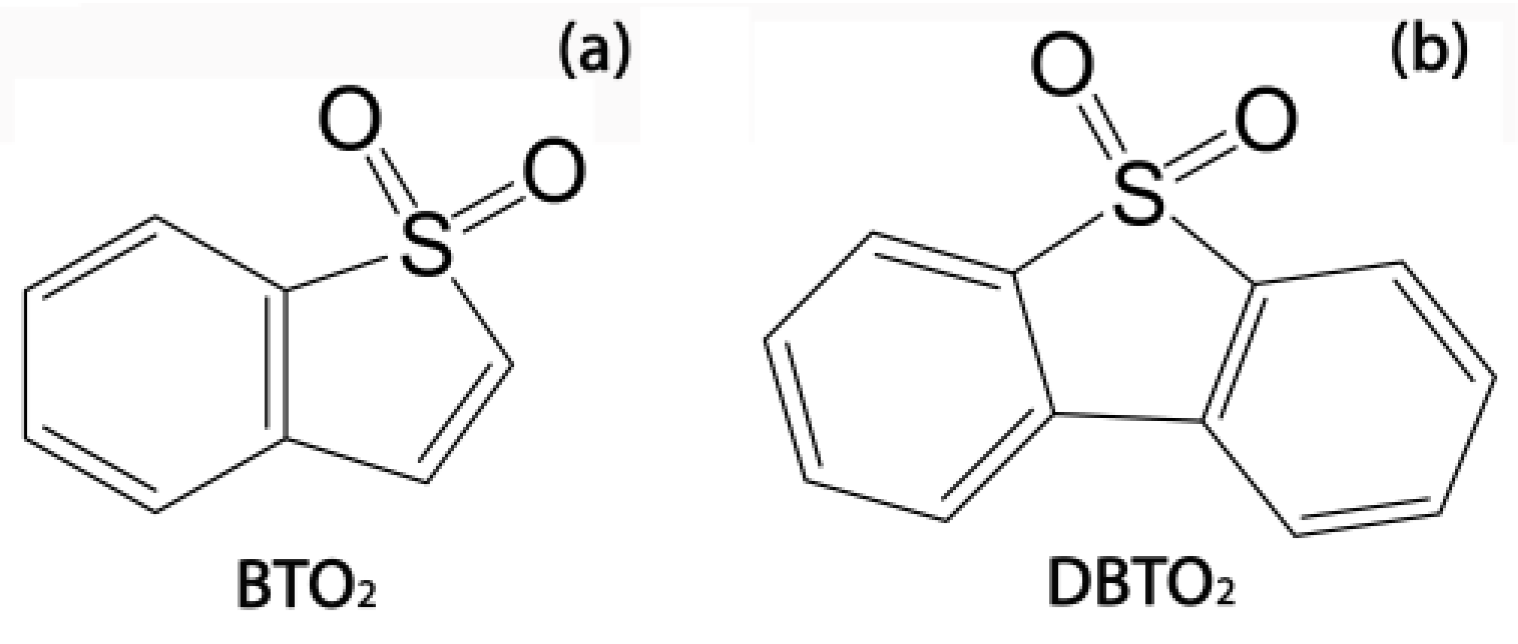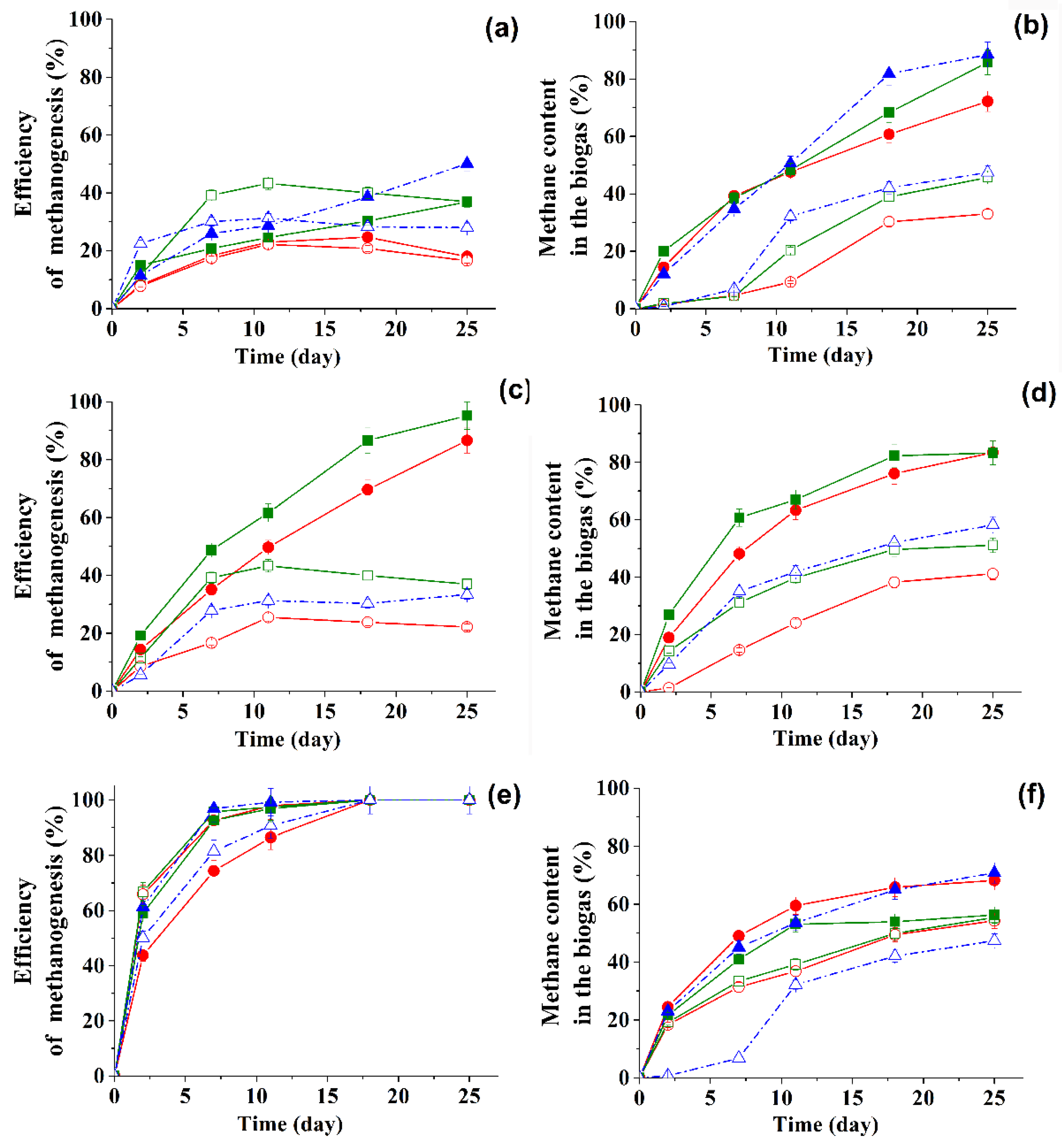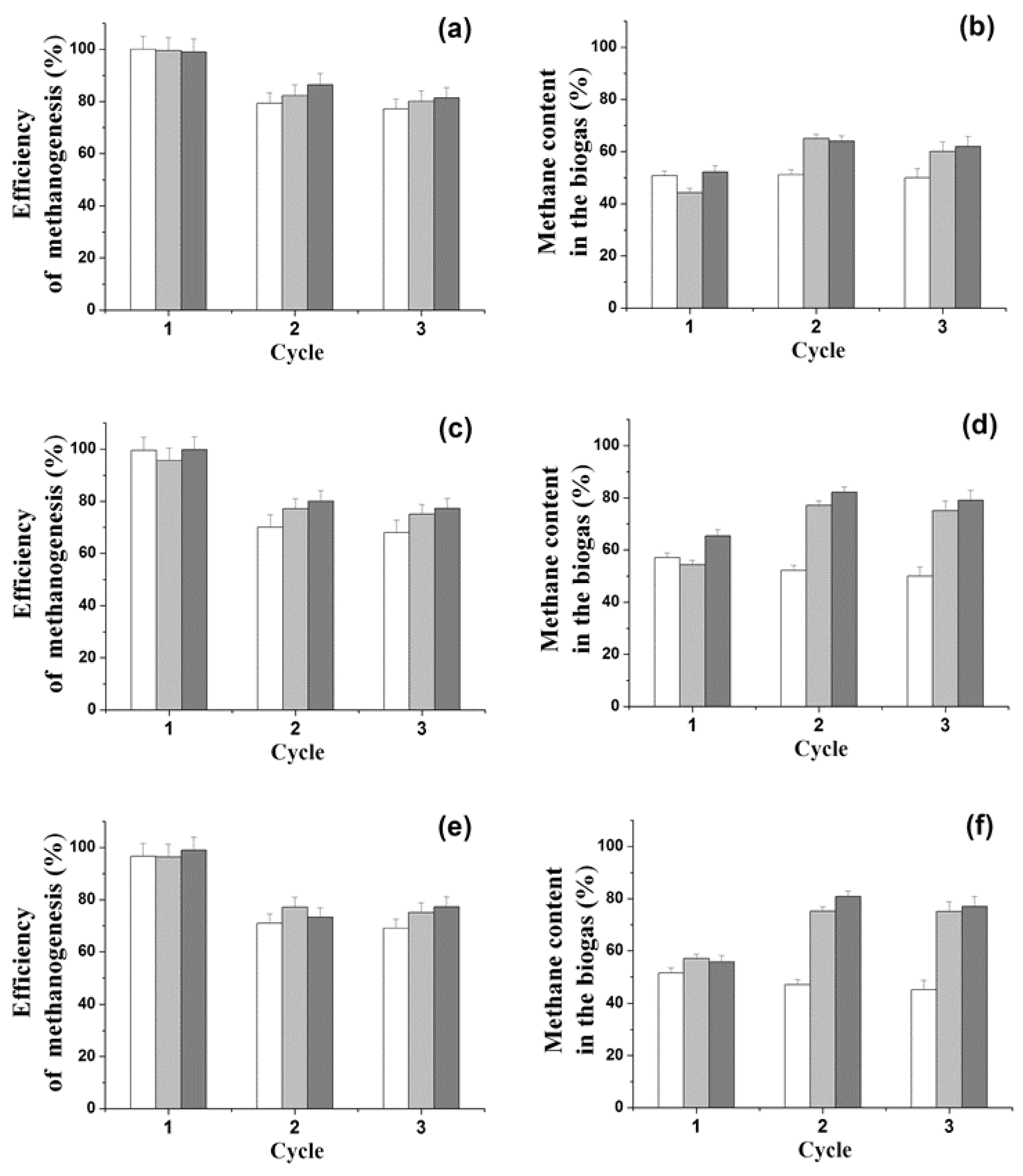Prospective Approach to the Anaerobic Bioconversion of Benzo- and Dibenzothiophene Sulfones to Sulfide
Abstract
1. Introduction
2. Results
2.1. Biotransformation Capabilities of Organic Sulfones to Sulfide under the Action of Anaerobic Biocatalysts
2.2. Estimation of the Energetic Status of Anaerobic Cells in Sulfons Bioconversion within Methanogenesis
2.3. Accumulation of Biogas under the Action of Immobilized AS in the Methanogenesis of Glucose Conducted in the Presence of Sulfones
2.4. Biogas Production under the Action of Combinations of Immobilized Biocatalysts during the Transformation of Glucose and Organic Sulfones under Batch Conditions
3. Discussion
4. Materials and Methods
4.1. Materials
4.2. Microorganisms and Culture Conditions
4.3. Immobilization of the Cells via Inclusion into the PVA Cryogel
4.4. Anaerobic Fermentation
4.5. Accumulation of Biogas and Determination of Its Composition
4.6. Determination of the Concentrations of Sulfide Ions and Sulfones
4.7. Determination of ATP Concentrations in Microbial Cells
4.8. Calculations
5. Conclusions
Author Contributions
Funding
Conflicts of Interest
References
- Sadare, O.; Obazu, F.; Daramola, M. Biodesulfurization of petroleum distillates—current status, opportunities and future challenges. Environments 2017, 4, 85. [Google Scholar] [CrossRef]
- Cao, M.; Ma, C. Review of coal-fired electrification and magnetic separation desulfurization technology. Appl. Sci. 2019, 9, 1158. [Google Scholar] [CrossRef]
- Zhang, L.; Li, Z.; Li, J.; Zhou, Y.; Yang, Y.; Tang, Y. Studies on the low-temp oxidation of coal containing organic sulfur and the corresponding model compounds. Molecules 2015, 20, 22241–22256. [Google Scholar] [CrossRef]
- Mishra, S.; Panda, S.; Pradhan, N.; Biswal, S.K.; Sukla, L.B.; Mishra, B.K. Microbe–mineral interactions: Exploring avenues towards development of a sustainable microbial technology for coal beneficiation. In Environmental Microbial Biotechnology; Sukla, L.B., Pradhan, N., Panda, S., Mishra, B.K., Eds.; Springer Publishing: Basel, Switzerland, 2015; pp. 33–52. ISSN 1613-3382. [Google Scholar]
- Caro, A.; Boltes, K.; Letón, P.; García-Calvo, E. Dibenzothiophene biodesulfurization in resting cell conditions by aerobic bacteria. Biochem. Eng. J. 2007, 35, 191–197. [Google Scholar] [CrossRef]
- Liu, L.; Guo, Z.; Lu, J.; Xu, X. Kinetic model for microbial growth and desulphurisation with Enterobacter sp. Biotechnol. Lett. 2015, 37, 375–381. [Google Scholar] [CrossRef] [PubMed]
- Traulsen, F.; Andersson, J.T.; Ehrhardt, M.G. Acidic and non-acidic products from the photo-oxidation of the crude oil component dibenzothiophene dissolved in seawater. Anal. Chim. Acta. 1999, 392, 19–28. [Google Scholar] [CrossRef]
- Weh, R.; de Klerk, A. Thermochemistry of sulfones relevant to oxidative desulfurization. Energ. Fuel. 2017, 31, 6607–6614. [Google Scholar] [CrossRef]
- Worthington, M.J.; Kucera, R.L.; Chalker, J.M. Green chemistry and polymers made from sulfur. Green Chem. 2017, 19, 2748–2761. [Google Scholar] [CrossRef]
- Van Lier, J.B.; Van der Zee, F.P.; Frijters, C.T.M.J.; Ersahin, M.E. Celebrating 40 years anaerobic sludge bed reactors for industrial wastewater treatment. Rev. Environ. Sci. Biotechnol. 2015, 14, 681–702. [Google Scholar] [CrossRef]
- Ziganshin, A.M.; Schmidt, T.; Scholwin, F.; Il’inskaya, O.N.; Harms, H.; Kleinsteuber, S. Bacteria and archaea involved in anaerobic digestion of distillers grains with solubles. Appl. Microbiol. Biotechnol. 2011, 89, 2039–2052. [Google Scholar] [CrossRef]
- Mora, M.; Lafuente, J.; Gabriel, D. Screening of biological sulfate reduction conditions for sulfidogenesis promotion using a methanogenic granular sludge. Chemosphere 2018, 210, 557–566. [Google Scholar] [CrossRef]
- Maslova, O.; Stepanov, N.; Senko, O.; Efremenko, E. Production of various organic acids from different renewable sources by immobilized cells in the regimes of separate hydrolysis and fermentation (SHF) and simultaneous saccharification and fermentation (SFF). Bioresour. Technol. 2019, 272, 1–9. [Google Scholar] [CrossRef] [PubMed]
- Senko, O.; Gladchenko, M.; Maslova, O.; Efremenko, E. Long-term storage and use of artificially immobilized anaerobic sludge as a powerful biocatalyst for conversion of various wastes including those containing xenobiotics to biogas. Catalysts 2019, 9, 326. [Google Scholar] [CrossRef]
- Stepanov, N.; Efremenko, E. “Deceived” concentrated immobilized cells as biocatalyst for intensive bacterial cellulose production from various sources. Catalysts 2018, 8, 33. [Google Scholar] [CrossRef]
- Stepanov, N.A.; Senko, O.V.; Efremenko, E.N. Biocatalytic production of the extracellular exopolysaccharide dextran, synthesized by cells of Leuconostoc mesenteroides. Catal. Ind. 2017, 9, 339–343. [Google Scholar] [CrossRef]
- Stepanov, N.; Efremenko, E. Immobilised cells of Pachysolen tannophilus yeast for ethanol production from crude glycerol. N. Biotechnol. 2017, 34, 54–58. [Google Scholar] [CrossRef]
- Kalyuzhnyi, S.V.; Shestakova, N.M.; Tourova, T.P.; Poltaraus, A.B.; Gladchenko, M.A.; Trukhina, A.I. Phylogenetic analysis of a microbial community involved in anaerobic oxidation of ammonium nitrogen. Microbiology 2010, 79, 237–246. [Google Scholar] [CrossRef]
- Treu, L.; Kougias, P.G.; Campanaro, S.; Bassani, I.; Angelidaki, I. Deeper insight into the structure of the anaerobic digestion microbial community; the biogas microbiome database is expanded with 157 new genomes. Bioresour. Technol. 2016, 216, 260–266. [Google Scholar] [CrossRef]
- Dhaked, R.K.; Singh, P.; Singh, L. Biomethanation under psychrophilic conditions: A review. Waste Manage. 2010, 30, 2490–2496. [Google Scholar] [CrossRef]
- Wu, B.; Bibeau, E.L. Development of 3-D anaerobic digester heat transfer model for cold weather applications. T. ASABE 2006, 49, 749–757. [Google Scholar] [CrossRef]
- Polikarpova, P.; Akopyan, A.; Shigapova, A.; Glotov, A.; Anisimov, A.; Karakhanov, E. Oxidative desulfurization of fuels using heterogeneous catalysts based on MCM-41. Energ. Fuel. 2018, 32, 10898–10903. [Google Scholar] [CrossRef]
- Akopyan, A.V.; Fedorov, R.A.; Andreev, B.V.; Tarakanova, A.V.; Anisimov, A.V.; Karakhanov, E.A. Oxidative desulfurization of hydrocarbon feedstock. Russ. J. Appl. Chem. 2018, 91, 529–542. [Google Scholar] [CrossRef]
- Gladchenko, M.A.; Kovalev, D.A.; Kovalev, A.A.; Litti, Y.V.; Nozhevnikova, A.N. Methane production by anaerobic digestion of organic waste from vegetable processing facilities. Appl. Biochem. Microbiol. 2017, 53, 242–249. [Google Scholar] [CrossRef]
- Gladchenko, M.A.; Gaydamaka, S.N.; Murygina, V.P.; Varfolomeev, S.D. The optimization of the conversion of agricultural waste into volatile fatty acids under anaerobic conditions. Moscow Univ. Chem. Bull. 2014, 69, 187–193. [Google Scholar] [CrossRef]
- Ismayilov, I.T.; Stepanov, N.A.; Efremenko, E.N.; Abbasov, V.M. Evaluation of biocidal properties of vegetable oil-based corrosion inhibitors using bioluminescent enzymatic method. Moscow Univ. Chem. Bull. 2015, 70, 197–201. [Google Scholar] [CrossRef]
- Efremenko, E.N.; Azizov, R.E.; Makhlis, T.A.; Abbasov, V.M.; Varfolomeev, S.D. Determination of minimal concentrations of biocorrosion inhibitors by a bioluminescence method. Appl. Biochem. Microbiol. 2005, 41, 377–381. [Google Scholar] [CrossRef]
- Efremenko, E.N.; Nikolskaya, A.B.; Lyagin, I.V.; Senko, O.V.; Makhlis, T.A.; Stepanov, N.A.; Maslova, O.V.; Mamedova, F.; Varfolomeyev, S.D. Production of biofuels from pretreated microalgae biomass by anaerobic fermentation with immobilized Clostridium acetobutylicum cells. Bioresour. Technol. 2012, 114, 342–348. [Google Scholar] [CrossRef] [PubMed]
- Efremenko, E.N.; Tatarinova, N.Y. The effect of long-term preservation of bacterial cells immobilized in poly(vinyl alcohol) cryogel on their viability and biosynthesis of target metabolites. Microbiology 2007, 76, 336–341. [Google Scholar] [CrossRef]
- Efremenko, E.N. Immobilized Cells: Biocatalysts and Processes; RIOR: Moscow, Russia, 2018; pp. 123–160. [Google Scholar] [CrossRef]
- Trukhina, A.I.; Gladchenko, M.A.; Kalyuzhnyi, S.V. Optimizations of sulfide and organic modifications of the DEAMOX process. Appl. Biochem. Microbiol. 2011, 47, 841–845. [Google Scholar] [CrossRef]
- Akopyan, A.V.; Fedorov, R.A.; Anisimov, A.V.; Eseva, E.A.; Karakhanov, E.A. Peroxide oxidative desulfurization of crude petroleum. Petrol. Chem. 2017, 57, 1132–1136. [Google Scholar] [CrossRef]
Sample Availability: Not available. |



| Biocatalyst | Form | Degree of Sulfone Conversion, % | Sulfide Yield, % 1 | ||
|---|---|---|---|---|---|
| The 8th Day | The 18th Day | The 8th Day | The 18th Day | ||
| 0.15 mM BTO2 | |||||
| AS I | S | 100 | 100 | 40.3 ± 1.9 | 87.9 ± 2.3 |
| Im | 100 | 100 | 97.8 ± 2.9 | 100 | |
| AS II | S | 100 | 100 | 68.1 ± 2.4 | 99.1 ± 0.9 |
| Im | 100 | 100 | 98.4 ± 1.6 | 100 | |
| AS III | S | 100 | 100 | 100 | 100 |
| Im | 100 | 100 | 100 | 100 | |
| 0.15 mM DBTO2 | |||||
| AS I | S | 100 | 100 | 26.4 ± 1.3 | 56.8 ± 1.8 |
| Im | 100 | 100 | 27.1 ± 1.3 | 61.4 ± 2.1 | |
| AS II | S | 100 | 100 | 70.2 ± 2.5 | 99.1 ± 0.9 |
| Im | 100 | 100 | 70.7 ± 2.5 | 100 | |
| AS III | S | 100 | 100 | 63.4 ± 2.1 | 98.4 ± 0.9 |
| Im | 100 | 100 | 87.9 ± 2.3 | 100 | |
| 0.45 mM DBTO2 | |||||
| AS I | S | 99.4 ± 0.2 | 100 | 26.6 ± 1.3 | 64.2 ± 2.2 |
| Im | 98.1 ± 0.2 | 100 | 26.7 ± 1.3 | 73.1 ± 2.6 | |
| AS II | S | 100 | 100 | 39.9 ± 1.9 | 67.8 ± 2.4 |
| Im | 98.1 ± 0.2 | 100 | 57.6 ± 2.5 | 97.5 ± 2.8 | |
| AS III | S | 99.1 ± 0.2 | 100 | 39.9 ± 1.9 | 100 |
| Im | 99.1 ± 0.2 | 100 | 64.2 ± 2.2 | 100 | |
| Biocatalysts and Their Combinations | Degree of Sulfone Conversion, % | Sulfide Yield, % 1 | ||
|---|---|---|---|---|
| The 8th Day | The 18th Day | The 8th Day | The 18th Day | |
| 0.15 mM BTO2 | ||||
| Desulfovibri vulgaris | 100 | 100 | 100 | 100 |
| 90% AS II + 10% D. vulgaris | 100 | 100 | 98.4 ± 1.4 | 100 |
| 90% AS III + 10% D. vulgaris | 100 | 100 | 100 | 100 |
| 90% AS III + 10% Clostridium acetobutilycum | 100 | 100 | 100 | 100 |
| 80% AS III + 10% D. vulgaris + 10% C. acetobutilycum | 100 | 100 | 100 | 100 |
| 0.15 mM DBTO2 | ||||
| D. vulgaris | 100 | 100 | 97.8 ± 1.7 | 100 |
| 90% AS II + 10% D. vulgaris | 100 | 100 | 62.1 ± 2.4 | 100 |
| 90% AS III + 10% D. vulgaris | 100 | 100 | 83.2 ± 3.1 | 100 |
| 90% AS III + 10% C. acetobutilycum | 100 | 100 | 88.5 ± 3.4 | 100 |
| 80% AS III + 10% D. vulgaris + 10% C. acetobutilycum | 100 | 100 | 91.8 ± 4.1 | 100 |
| 0.45 mM DBTO2 | ||||
| D. vulgaris | 99.4 ± 0.2 | 100 | 73.1 ± 2.6 | 100 |
| 90% AS II + 10% D. vulgaris | 99.1 ± 0.2 | 100 | 48.7 ± 2.3 | 97.5 ± 2.1 |
| 90% AS III + 10% D. vulgaris | 99.1 ± 0.2 | 100 | 84.2 ± 3.2 | 99.7 ± 0.3 |
| 90% AS III + 10% C. acetobutilycum | 100 | 100 | 100 | 100 |
| 80% AS III + 10% D. vulgaris + 10% C. acetobutilycum | 100 | 100 | 99.7 ± 0.3 | 100 |
| Biocatalyst | Form | Concentration of Intracellular ATP, × 10−12 mol/mg DCW 1 | |||
|---|---|---|---|---|---|
| Control | 0.15 mM BTO2 | 0.15 mM DBTO2 | 0.45 mM DBTO2 | ||
| AS I | S | 50.2 ± 1.8 | 1.5 ± 0.1 | 3.2 ± 0.2 | 2.9 ± 0.1 |
| Im | 55.2 ± 1.8 | 5.7 ± 0.2 | 25.1 ± 0.9 | 4.1 ± 0.2 | |
| AS II | S | 44.6 ± 1.4 | 4.3 ± 0.2 | 4.2 ± 0.2 | 9.1 ± 0.4 |
| Im | 36.5 ± 1.4 | 16.9 ± 0.7 | 19.4 ± 0.7 | n/d2 | |
| AS III | S | 55.7 ± 1.9 | 17.1 ± 0.7 | 25.7 ± 0.9 | 33.5 ±1.3 |
| Im | 52.3 ± 1.9 | 27.3 ± 1.1 | 20.8 ± 0.8 | 31.1 ± 1.2 | |
| D. vulgaris | Im | 7.1 ± 0.2 | 4.1 ± 0.2 | 4.1 ± 0.2 | n/d |
| C. acetobutilycum | Im | 66.1 ± 3.1 | 12.1 ± 0.5 | 11.1 ± 0.4 | 18.2 ± 0.7 |
| AS-Sample | Source 1 | Dry Matter, g/L | Ash, % | Biomass VSS, g/L |
|---|---|---|---|---|
| I | Frito Lay plant (Kashira,) | 62.9 ± 3.1 | 44.3 ± 0.8 | 34.7 ± 1.2 |
| II | Methane tank processing cattle farm waste (Dmitrov) | 44.6 ± 1.5 | 35.8 ± 1.1 | 28.6 ± 0.1 |
| III | Brincalov plant (Dolgoprudniy) | 79.9 ± 3.6 | 37.9 ± 1.7 | 49.6 ± 1.4 |
© 2019 by the authors. Licensee MDPI, Basel, Switzerland. This article is an open access article distributed under the terms and conditions of the Creative Commons Attribution (CC BY) license (http://creativecommons.org/licenses/by/4.0/).
Share and Cite
Senko, O.; Maslova, O.; Gladchenko, M.; Gaydamaka, S.; Akopyan, A.; Lysenko, S.; Karakhanov, E.; Efremenko, E. Prospective Approach to the Anaerobic Bioconversion of Benzo- and Dibenzothiophene Sulfones to Sulfide. Molecules 2019, 24, 1736. https://doi.org/10.3390/molecules24091736
Senko O, Maslova O, Gladchenko M, Gaydamaka S, Akopyan A, Lysenko S, Karakhanov E, Efremenko E. Prospective Approach to the Anaerobic Bioconversion of Benzo- and Dibenzothiophene Sulfones to Sulfide. Molecules. 2019; 24(9):1736. https://doi.org/10.3390/molecules24091736
Chicago/Turabian StyleSenko, Olga, Olga Maslova, Marina Gladchenko, Sergey Gaydamaka, Argam Akopyan, Sergey Lysenko, Eduard Karakhanov, and Elena Efremenko. 2019. "Prospective Approach to the Anaerobic Bioconversion of Benzo- and Dibenzothiophene Sulfones to Sulfide" Molecules 24, no. 9: 1736. https://doi.org/10.3390/molecules24091736
APA StyleSenko, O., Maslova, O., Gladchenko, M., Gaydamaka, S., Akopyan, A., Lysenko, S., Karakhanov, E., & Efremenko, E. (2019). Prospective Approach to the Anaerobic Bioconversion of Benzo- and Dibenzothiophene Sulfones to Sulfide. Molecules, 24(9), 1736. https://doi.org/10.3390/molecules24091736







